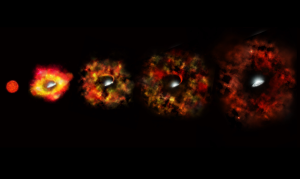Blog
Massive Fail
24 May 2018
 NASA, ESA, and P. Jeffries (STScI)
NASA, ESA, and P. Jeffries (STScI)When a star like our Sun dies, it does so rather calmly. It swells to a red giant for a time, then collapses into a white dwarf. But large stars end much more violently. When a large star runs out of hydrogen to fuse, it starts fusing heavier elements until eventually its core collapses under its own weight. This triggers an explosion that rips the star apart, known as a core collapse supernova. For a brief time a supernova can shine brighter than an entire galaxy. After the supernova, the remaining core can collapse into a neutron star or black hole.
But there has been a bit of a mystery about supernovae. We know that in the early universe there were truly massive stars. Much larger than the stars we typically see today. You would think that these supermassive stars would create brilliant supernovae, but extremely bright supernovae (sometimes called hypernovae) are quite rare. So what gives? One idea has been that when a supermassive star collapses, its tremendous gravity prevents the exploding star from becoming a supernova. Basically, it collapses into a black hole before much of the outer layers of the star can escape, so instead of a massive explosion, the star undergoes a massive fail.
Recently a team of astronomers observed such a massive fail for the first time.1 Given the name N6946-BH1, it was a star about 25 times more massive than our Sun, located in a spiral galaxy about 22 million light years away. In 2009 the star started to brighten, much as a star might before becoming a supernova. But over the next few years it faded, and by 2015 it had faded away. There are a few things that can make a star brighten and fade like this, such as a nova or stellar merger, but careful analysis showed these weren’t the case. An infrared survey of the region near the star also confirmed that it wasn’t simply obscured by interstellar dust. So the most likely explanation is that it collapsed into a black hole.
The next step is to confirm that N6946-BH1 has, in fact become a black hole. Then the question is whether such massive fails are common or rare. If a significant fraction of stars can die without becoming a supernova, then that could explain why we don’t see hypernova explosions more often.
S. M. Adams, et al. “The search for failed supernovae with the Large Binocular Telescope: confirmation of a disappearing star” MNRAS, Volume 468, Issue 4, 11 Pages 4968–4981, 2017. ↩︎